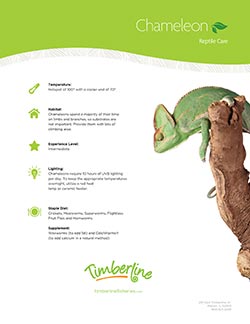Caring for Chameleons
including Veiled, Panther and Jackson
The Veiled Chameleon is a relatively large chameleon species originally from Saudi Arabia and Yemen in the middle east. In it’s natural range, the Veiled chameleon lives in coastal mountain slopes which experience significant rainfall and some live in slightly more arid areas with year round water and vegetation. Panther Chameleons are native to Madagascar and are able to turn a variety of colors depending on their locale or area from which they originated. Jacksons Chameleons are native to Africa and are found in three varieties, the seldom seen Chamaeleo jacksonii jacksonii, the C.j. merumonta and the C.j. xantholophus. Chameleons should be fed a staple diet of crickets and mealworms although crickets are preferred as chameleons are active hunters and exciting to watch hunt. In general, crickets should be as long as the width of the chameleons head. Baby chameleons can be started on a diet flightless fruit flies.
Baby and juvenile chameleons should be fed twice a day and have almost constant access to food. As they get older, they can be fed less often with adults being fed every other day. Calcium is very important to promote proper growth and health. As babies and juveniles, supplement with CalciWorms® 3 times a week for proper calcium needs. As adults, decrease to once or twice a week. Waxworms are intended to be used to add fat to a chameleons diet or the occasional treat. Being arboreal, chameleons do not typically encounter standing water like found in a typical water dish. They drink water from morning dew and rain that has fallen onto leaves. It is important to mist enclosures with a spray bottle twice a day for two mins. Chameleons will lap up water from the leaves. Drip systems are also good for sources of water for chameleon enclosures.
Staple Diet:
Crickets, Mealworms, Superworms, Flightless Fruit Flies and Hornworms
Supplement:
Waxworms (to add fat) and CalciWorms® (to add calcium in a natural method)

